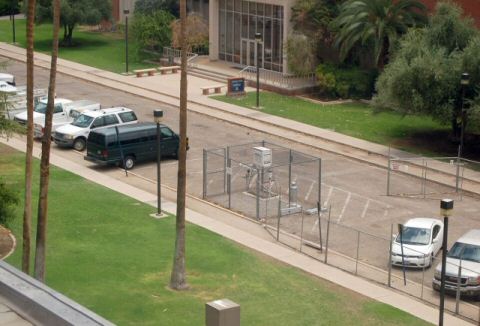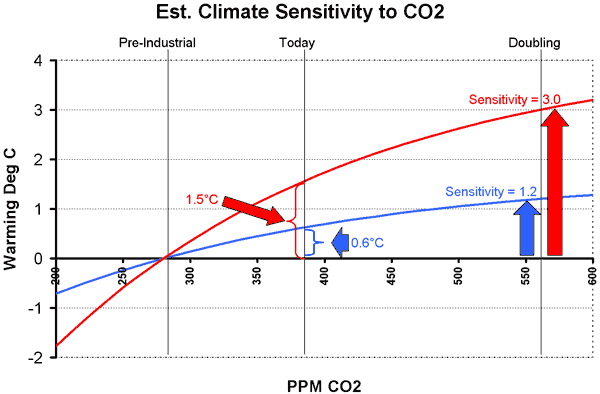I'm on the Front Page, But Don't Bother to Look
The Arizona Republic had a stealth hit piece on skeptics in the paper today and, unfortunately, I inadvertently helped. My kids woke me up at 7:00 this morning (Yuk!) to tell me I was on the front page of the Arizona Republic. I was quoted a couple of times in an article on climate change skeptics. I have a couple of thoughts about an article that really has me depressed today. If you want to know what I really think about climate, see my book and in my movie (both free online).
- After interviews, I am always surprised at what the writers chose to quote, and this article is no exception.
- I spent most of the article trying to explain this simple data exercise, but I guess newspapers today are science-phobic and would rather write he-said-she-said articles than actually get into the numbers. Unfortunately, the article leaves the impressions that we skeptics have problems with catastrophic global warming theory "just because."
- The article is not about the skeptics' position, because it is not really stated. In fact, more space is spent on refuting skeptics than is even given to skeptics themselves. Here is the best test: The skeptic's position would have been better served by not publishing this mess at all.
- Almost my entire discussion with the reporter was about the forecasts. I said man is causing some warming, but there are simple tests to show it likely won't be catastrophic. I even said that it was the catastrophists tactic not to argue this point, but to shift the debate to whether warming exists at all, where they have a much stronger argument. Despite this whole discussion with the reporter, the reporter allowed the catastrophists to shift the debate again. They want to argue whether things are warmer, where they are on strong ground, and not about how much it will warming the future and whether this will justify massive government intervention, where they are on weak ground.
This article really frustrates me, and may pretty much spell the end for my ever giving an interview on the subject again (I will do a podcast on Monday, which I will link soon, but that is different because they can't edit me). Despite it being an article about skeptics, the catastrophists are the only one that get any empirical evidence whatsoever into the article (however lame it may be). This really ticked me off in particular: I spent an hour giving specific empirical reasons why there were problems with forecasts and the theory. The reporter then just printed a few quotes from me that made me look like an uninformed idiot, saying "just because." Then they print this:
"There is clearly a group of thought that says because we're not seeing
debate now, it never happened in the scientific community," Huxman
said. "That is simply wrong. It did happen, and it's over. The debate
now is over the idiosyncrasies, the internal workings."
Incredibly, they also credulously reprint the absurd Newsweek ad hominem attacks on skeptics.
What also got my attention was the companion article on an ASU professor who is a climate skeptic. Incredibly, in the whole article, not one sentence is dedicated to explaining why the professor is a skeptic. What is the empirical evidence he relies on, or the analysis he finds most compelling? We never find out. All we get is an article on dueling motivations. For example, the Republic writes:
Despite his notoriety as a hero of the skeptic crowd, Balling's research and lifestyle contain some surprising contradictions.
He is in charge of climate studies at the Decision Center for a Desert
City, an ambitious ASU program that looks at how drought will affect
the Valley.He's a registered independent and lives a lifestyle that the hardiest environmental activist would recognize as green....
If there was a competition for living green, "put the cards on the
table, and I'll beat 99 percent of the faculty here," Balling said.He avoids driving and doesn't own a cellphone.
He would even have liked to see Al Gore win the presidency in 2000.
So? Why is this surprising? Should we all naturally expect that skeptics all eat children for dinner? And, of course, an article on a leading skeptic would not be complete without this:
Critics have assailed Balling's ties to industries.
Balling received more than $679,000 in research funding from
fossil-fuel-industry organizations between 1989 and 2002, according to
figures provided by ASU. He served as a scientific adviser to the
Greening Earth Society, a public-relations organization founded by the
Western Fuels Association to promote the benefits of global warming.
Uh, OK. Here is a Coyote Blog challenge: Find me one article in a mainstream newspaper or news weekly that even once checks the sources of funding for climate catastrophists. This focus on funding and motivation and political affiliation for skeptics only is scandalously asymmetric. But take a quick look at the article - 85% of it is related to motivation, either how good his green credentials are or how much money he gets from oil companies - and not any discussion of what he actually thinks.
This final bit is especially funny. Think of all the wacko professors out there that are warmly accepted by their universities and the academic community. We're talking about folks all the way up to and including men who have gone to prison for torturing and murdering women. But apparently having a climate skeptic on the faculty is just too much:
But his climate work has garnered the most national attention, which bothers some colleagues at ASU.
"For ASU, having Balling as such a prominent figure in the climate
debate has been awkward, not so much because of his positions but
because we have lacked scientists of similar stature whose work
supports more widely held, opposing views," Jonathan Fink, director of
ASU's Global Institute of Sustainability, wrote in an e-mail. "Hence we
have been viewed as somewhat of a fringe institution in the world of
climate-change research."
Wow, its terrible to see such ill-repute brought to America's #1 Party School. And by the way, what the hell kind of strategy is this? We want to make a name for ourselves in climate research, so to do so we think we should be just like all the other schools -- that's the way to differentiate ourselves!
I will post links to my podcast that is coming up Monday night. After that, I am not sure. I am pretty depressed about the state of the media on this issue. I have a lot of interests and more than enough to do with my time that I may take a break from climate for a while.


